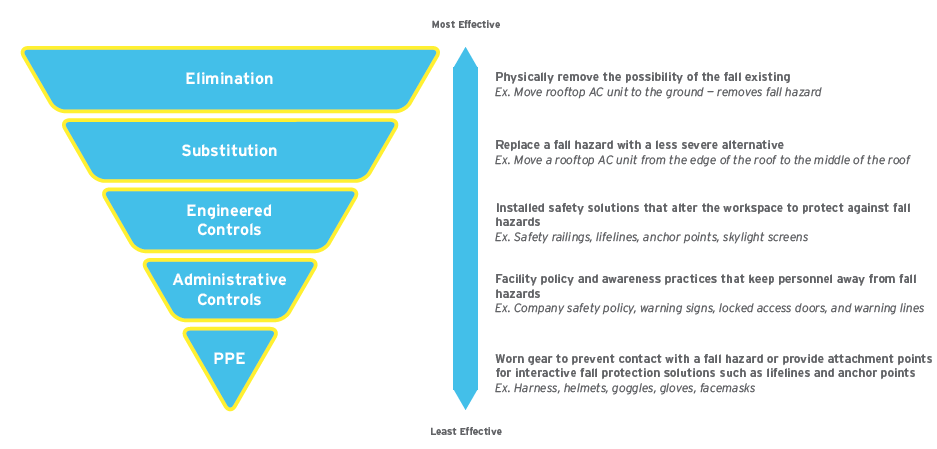Why There’s Caution Tape Around Administrative Controls
Ever walked into a bank and wondered why they don’t keep stacks of money in the lobby with caution tape around it? Of course not! Caution tape alone is not stopping a random person from taking the money. This is why banks keep their money securely locked away in the vault. This impenetrable barrier physically stops people from gaining access to the money.
We can and should apply this same analogy to the fall protection hierarchy of controls. One of the last options on the hierarchy is administrative controls. The reason it’s not the most effective - or the safest option is because it leaves room for human error. The purpose of an administrative control is to create an environment that triggers a behavioral response from a worker, which in theory, should deter them from exposing themself to the hazard.

Zoom out
The fall protection hierarchy of controls exists as a road map for safety professionals to use when determining what type of fall protection will best protect their workers from a fall hazard. The more favorable methods of fall protection are those that most distance workers from a fall hazard, hence why elimination is ranked number one. If you can remove the hazard completely, then there is no longer a danger to you or your workforce. You want to make sure you exhaust all your options on the hierarchy before moving to the next control.
Administrative controls aim to create a mental barrier between a worker and the fall hazard through training, supervision, or other instruction. The work rules are often supplemented by tangible warnings like walking paths, caution tape, and signage. Although helpful, these will not physically stop someone from falling and getting injured, rather they just deter a worker from exposure to the hazard.
Thanks, Murphy
Even your best employees might duck under the caution tape or take the shortest route to the HVAC system. And that includes safety managers. Now, imagine if a guest or pedestrian were to walk onto your job site or rooftop. Caution tape will not stop them from being exposed to the hazard - they don’t have the proper training. However, just like a bank vault door, adding an engineering control like guardrail would be more effective.
Administrative controls don’t work well on their own. They require proper planning, execution, and maintenance to be effective. If a walkway is covered by snow, caution tape is blown away, or someone is not properly trained, the administrative control will fail.
Managing administrative controls the right way
If you do use administrative controls, the user must understand how to follow them correctly. Since administrative controls typically rely on visual queues to alert nearby workers to the hazard, it’s important to routinely inspect that the visual queues are still functioning (i.e. walkway is visible and easy to traverse, caution tape is visible and intact). This is especially important in outdoor environments where weather can deteriorate those types of controls.
It’s also important that anyone who will be working or traveling in the immediate area of the administrative controls has a proper understanding of what they mean. This requires that those individuals receive instruction. Training, documentation, and other tools can be used to help the worker know which administrative controls you have enacted and what your expectations are with regards to following them.
Don’t forget supervision - human nature appreciates the shortest path, so if your walkway navigates around hazards the “long way” you may need to add cameras, check-in/access permissions, etc to limit the potential of a worker bypassing your controls. Of course, you can mitigate the risk by moving up the hierarchy and installing temporary engineering controls like portable guardrails for a short-term project, or even permanent guardrails to create a long-term safe working-walking surface.
Approaching a problem the right way
Start by reviewing your hierarchy during a Job Hazard Analysis and disqualify controls from the top down. Be sure to collaborate with other stakeholders so you can resolve all relevant concerns and implement safe and effective controls that will protect your employees.
Jumping down to administrative controls may seem easy, but the work to make them effective is critical for success. It’s tempting in a pinch, but proper methodology will provide your employees with the safety they deserve. The team at Simplified is available to help you navigate this complex question with a rooftop hazard assessment.



